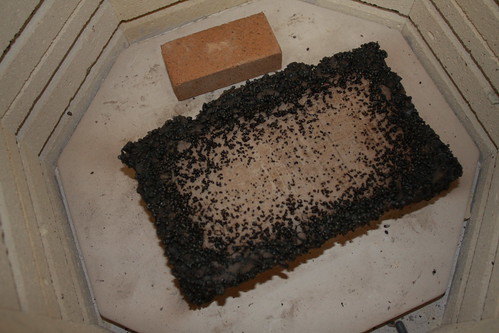First off, a mouse or two discovered the clay blocks with implated seed and started eating them. After a two day excursion in garage emptying cleaning and putting back the garage is free of mouse bait and the remnants of the mice. On the upside the garage is organized better now and we got a bunch of crap thrown out.
This included the partially fired block. They made a small hole in the side of it nad hollowed out the unfired core. I have not figured out how to use this little phenomina. However, it did give me an idea for an alternate approach I would like to try. That is slip casting hollow blocks. Basic idea would be this:
- Mix the clay / sawdust or poly styrene dust mix with enough water to make it into slip, very thin clay.
- Pour the slip into a simple plaster mold & allow to set until a 3/8" +/- wall forms, pour our the rest of the slip. This is just like alot of ceramic products are made.
- Dry & fire.
Next, I took the remaining blocks and fired them.
- I did a ramp to 900 and held that for about eight hours to accomplish as full a burn out as possible.
- Then I took them to cone 8 with a tow hour hold at the top. Took about 10 hours with my kiln.
- I kept the bung in to minimize the oxygen present and the burn rate. My thinking was that it would limit the fracturing in the blocks.
- The transitioin through to 900 and the hold created the same results as below but eventually all the black goo burned off. Did not smell good. Burnt popcorn would be about right. Fortunately it was breezy. The smell blew away.
- The blocks remaining pretty much in tact.
- The blocks did crumble once I tried to pick them up.
- This time there were regions that retained some strength. Not much. Maybe 20 psi. That gave me some hope the clay mix might have enough strength.
- Last but not least, in the middle there was still a lot of carbonized material left. That tells me that after all that time in there at ~ 2300 F the core was probably not more than 600 degrees F.
- The seed idea is not going to work. I think the combination of the large voids / thin walls and the expansion of the organics during burn out is destroying the structural ingerity to the point where even a pretty high fire will not allow any fusing to occur.
- A smaller particle size on the combustible material should yield a stronger matrix.
- The insulating properties are great!
- I don't need 1 1/2 inch thick slabs. 3/4 inch will probably do it. Assuming a similar ratio of burn out material.
- The hollow slip casting method is worth a shot.
Later,
John

